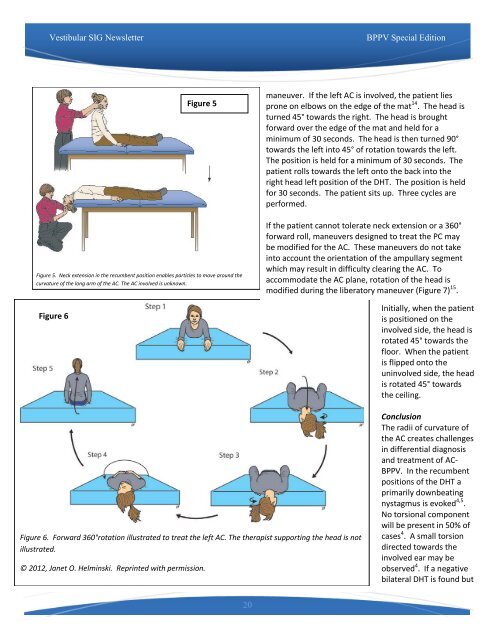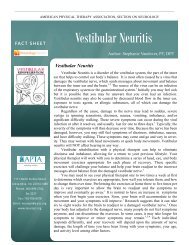Practice Guidelines for BPPV - Neurology Section
Practice Guidelines for BPPV - Neurology Section
Practice Guidelines for BPPV - Neurology Section
You also want an ePaper? Increase the reach of your titles
YUMPU automatically turns print PDFs into web optimized ePapers that Google loves.
Vestibular SIG Newsletter <strong>BPPV</strong> Special Edition<br />
Figure 5. Neck extension in the recumbent position enables particles to move around the<br />
curvature of the long arm of the AC. The AC involved is unknown.<br />
Figure 6<br />
Figure 5<br />
Figure 6. Forward 360°rotation illustrated to treat the left AC. The therapist supporting the head is not<br />
illustrated.<br />
© 2012, Janet O. Helminski. Reprinted with permission.<br />
20<br />
maneuver. If the left AC is involved, the patient lies<br />
prone on elbows on the edge of the mat 14 . The head is<br />
turned 45° towards the right. The head is brought<br />
<strong>for</strong>ward over the edge of the mat and held <strong>for</strong> a<br />
minimum of 30 seconds. The head is then turned 90°<br />
towards the left into 45° of rotation towards the left.<br />
The position is held <strong>for</strong> a minimum of 30 seconds. The<br />
patient rolls towards the left onto the back into the<br />
right head left position of the DHT. The position is held<br />
<strong>for</strong> 30 seconds. The patient sits up. Three cycles are<br />
per<strong>for</strong>med.<br />
If the patient cannot tolerate neck extension or a 360°<br />
<strong>for</strong>ward roll, maneuvers designed to treat the PC may<br />
be modified <strong>for</strong> the AC. These maneuvers do not take<br />
into account the orientation of the ampullary segment<br />
which may result in difficulty clearing the AC. To<br />
accommodate the AC plane, rotation of the head is<br />
modified during the liberatory maneuver (Figure 7) 15 .<br />
Initially, when the patient<br />
is positioned on the<br />
involved side, the head is<br />
rotated 45° towards the<br />
floor. When the patient<br />
is flipped onto the<br />
uninvolved side, the head<br />
is rotated 45° towards<br />
the ceiling.<br />
Conclusion<br />
The radii of curvature of<br />
the AC creates challenges<br />
in differential diagnosis<br />
and treatment of AC-<br />
<strong>BPPV</strong>. In the recumbent<br />
positions of the DHT a<br />
primarily downbeating<br />
nystagmus is evoked 4,5 .<br />
No torsional component<br />
will be present in 50% of<br />
cases 4 . A small torsion<br />
directed towards the<br />
involved ear may be<br />
observed 4 . If a negative<br />
bilateral DHT is found but

















